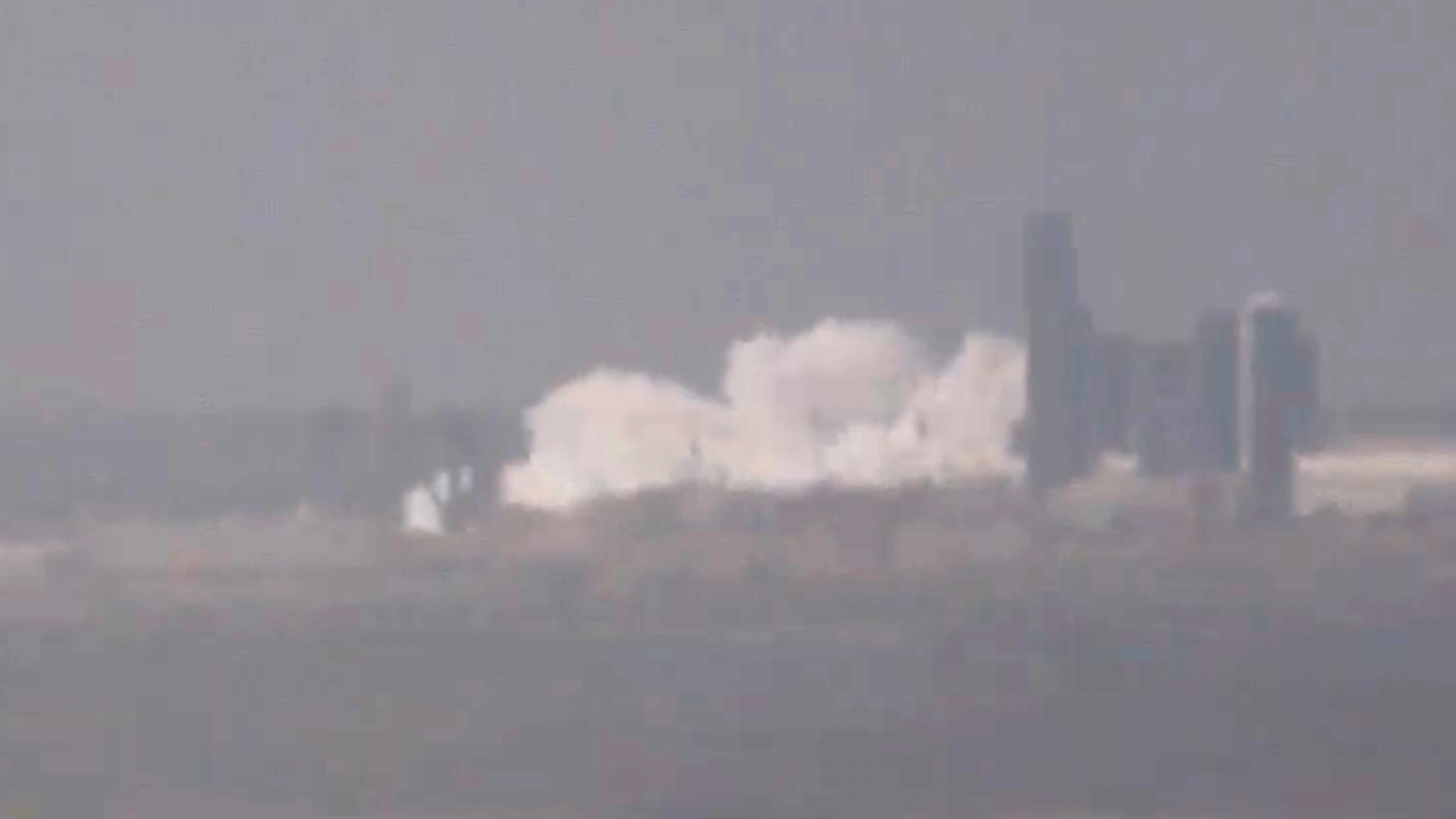Boom! SpaceX pops huge Starship SN7 test tank on purpose in pressure test (videos)
RIP, Starship SN7.
SpaceX pushed a massive tank for its latest Starship prototype beyond its limits Tuesday (June 23) in an intentionally explosive test in South Texas.
The Starship SN7 prototype tank ruptured during a pressure test at SpaceX's Boca Chica proving grounds, the second in just over a week for the spacecraft component. But where a June 15 test resulted in a leak, Tuesday's test was a bit more dramatic.
Video cameras from the South Padre Island tourism site Spadre.com and NASASpaceflight.com watched as SpaceX filled the tank with super-chilled liquid nitrogen to test its ability to hold super-cold propellant during an actual launch. The tank eventually reached its limit and burst, spewing out billowing white nitrogen clouds.
A close up from NASASpaceflight.com on Twitter , captured by Starship watcher Mary (also know as BocaChicaGal), shows the moment the tank ruptured. The tank pops and collapses, sinking into the nitrogen plumes.
RIP SN7 Test Tank. Thanks for the data!Mary (@BocaChicaGal) livestream!https://t.co/wlq79ZvdkL pic.twitter.com/gCYRkpDMW7June 23, 2020
SpaceX has been performing a series of tests at Boca Chica to refine its designs for the stainless steel Starship, which the company aims to use for eventual Mars flights and moon landings. Last month, NASA picked Starship as one of three commercial moon lander designs that could land the agency's Artemis astronauts to the moon.
Some of SpaceX's Starship tests have been successful, such as a series of ground-based rocket engine tests and the brief 2019 flight of an early Starship prototype called Starhopper. Others, not so much.

On May 29, SpaceX's SN4 Starship prototype exploded shortly after completing a test of its Raptor rocket engine .
Get the Space.com Newsletter
Breaking space news, the latest updates on rocket launches, skywatching events and more!
SpaceX CEO Elon Musk has said the company will learn from each Starship test to improve future designs. Last week's test of the SN7 Starship tank, which leaked but did not explode, was a promising sign, Musk said on June 15. The company is shifting from 301 stainless steel to 304L, he has said.
"Tank didn't burst, but leaked at 7.6 bar. This is a good result & supports idea of 304L stainless [steel] being better than 301," Musk tweeted wrote on Twitter, adding that the tank would eventually be used in a destructive test. "We're developing our own alloy to take this even further. Leak before burst is highly desirable."
- SpaceX: Facts about Elon Musk's private spaceflight company
- Welders wanted: SpaceX is hiring to ramp up production of stainless steel Starship
- How living on Mars could challenge colonists (infographic)
Email Tariq Malik at tmalik@space.com or follow him @tariqjmalik. Follow us @Spacedotcom, Facebook and Instagram.
OFFER: Save 45% on 'All About Space' 'How it Works' and 'All About History'!
For a limited time, you can take out a digital subscription to any of our best-selling science magazines for just $2.38 per month, or 45% off the standard price for the first three months.
Join our Space Forums to keep talking space on the latest missions, night sky and more! And if you have a news tip, correction or comment, let us know at: community@space.com.

Tariq is the Editor-in-Chief of Space.com and joined the team in 2001, first as an intern and staff writer, and later as an editor. He covers human spaceflight, exploration and space science, as well as skywatching and entertainment. He became Space.com's Managing Editor in 2009 and Editor-in-Chief in 2019. Before joining Space.com, Tariq was a staff reporter for The Los Angeles Times covering education and city beats in La Habra, Fullerton and Huntington Beach. In October 2022, Tariq received the Harry Kolcum Award for excellence in space reporting from the National Space Club Florida Committee. He is also an Eagle Scout (yes, he has the Space Exploration merit badge) and went to Space Camp four times as a kid and a fifth time as an adult. He has journalism degrees from the University of Southern California and New York University. You can find Tariq at Space.com and as the co-host to the This Week In Space podcast with space historian Rod Pyle on the TWiT network. To see his latest project, you can follow Tariq on Twitter @tariqjmalik.
-
Bruce Perens K6BP Darkforce, what about its cryogenic properties? It's holding liquid oxygen in a potentially close to absolute zero environment, and of course it can also get hot in the sun - so hot outside and very cold inside. I heard that SpaceX has formulated their own variant of 314, which they will eventually use - it's more expensive than off-the-shelf so not used in this round of testing.Reply










